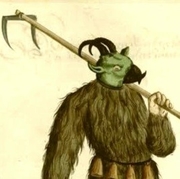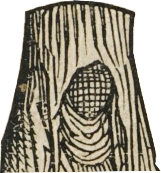|
excessive genital girth reduces the human body's natural aerodynamic qualities, and thus proves to be a disadvantage in discus-throwing, the shotput, naked wrestling, and other such platonic sporting activities
|
|
|
|

|
| # ? Jun 2, 2024 12:33 |
|
https://twitter.com/archeometrie/status/1170031822614474752?s=19
|
|
|
|
big dong wanter posted:Is it true that the Greeks were all about tiny dicks? The reason their statuary is like that is more down to a problem of construction than necessarily to taste. If you carve a dude with a massive dick or raging boner, odds are it'll get broken off the statue in fairly short order and uuuh that doesn't leave the best image behind, so Greek statue artists quickly learned to make it as integral a part of the larger figure as they could, thus the small/limp dicks.
|
|
|
|
Build a wall and make the Picts pay for it! https://www.youtube.com/watch?v=X43GoLPzZeA https://www.youtube.com/watch?v=LeosZImCrMY
|
|
|
|
Captain_Maclaine posted:The reason their statuary is like that is more down to a problem of construction than necessarily to taste. If you carve a dude with a massive dick or raging boner, odds are it'll get broken off the statue in fairly short order and uuuh that doesn't leave the best image behind, so Greek statue artists quickly learned to make it as integral a part of the larger figure as they could, thus the small/limp dicks.
|
|
|
|
big dong wanter posted:hmm,that doesnt make much sense bc i doubt that greek sculptors were that concerned about how their carved cocks would look in a few thousand years It usually would happen within a year or two, if not sooner.
|
|
|
|
https://www.newstatesman.com/culture/2014/06/mary-beard-humour-ancient-rome-was-matter-life-and-deatquote:In Rome that entailed, for a start, being a sport when it came to taking a joke, especially from the plebs. The first emperor, Augustus, even managed to stomach jokes about that touchiest of Roman topics, his own paternity. Told that some young man from the provinces was in Rome who was his spitting image, the emperor had him tracked down. “Tell me,” Augustus asked, “did your mother ever come to Rome?” (Few members of the Roman elite would have batted an eyelid at the idea of some grand paterfamilias impregnating a passing provincial woman.) “No,” retorted the guy, “but my father did, often.”
|
|
|
|
Captain_Maclaine posted:The reason their statuary is like that is more down to a problem of construction than necessarily to taste. If you carve a dude with a massive dick or raging boner, odds are it'll get broken off the statue in fairly short order and uuuh that doesn't leave the best image behind, so Greek statue artists quickly learned to make it as integral a part of the larger figure as they could, thus the small/limp dicks. they got big dicks on priapus statues but usually they find a way to incorporate the girth into another element like the bottom fringe of a tunic pulled up in the front to expose the dong
|
|
|
|
twoday posted:If you can summarize for me in a few sentences the basic relationship between the sun and the earth, and the relationship between ancient humans and the sun, and the relationship between this understanding and archaeoastronomical sites such as the ones I listed above, then I will tell you further interesting astronomical facts about the ancient world. If you can't, then study the things I mentioned until you understand it, for it is one of the most fundamental pillars of all human civilizations everywhere in the world. I'm going to mention Cahokia because I live in the area! It's probably less interesting to read about if you haven't walked around the place and seen the scale and relative positions of everything.  The mounds are cool and are oriented to the compass rose and all, but the most interesting astronomical feature of Cahokia is the woodhenge, a bunch of evenly-spaced wooden poles that were erected due west of Monk's Mound, so that if you stand at the center of the woodhenge during sunrise at the equinox, the sun rises directly over the Mound. There are also marked "solstice" poles to show where the sun rises and sets on the winter solstice (at Cahokia's northern latitude, in winter, when axial tilt is beaming sunlight to the southern hemisphere, the sunrise/set is to the southeast/southwest) and where the sun rises and sets on the summer solstice (northeast/northwest), and the wooden poles in between let you know what time of year it is otherwise. Knowing how the sun moves and how time passes around these parts was (and still is!) useful to people because it let them/lets us know when to plant crops, when tornado season starts, when the Mississippi is going to inevitably flood, that if you want to save on energy bills and have partial-light houseplants it's best to get a place with a south-facing window with an overhang because then you get more sun in winter and less in summer (even though the sun swoops south across the sky, it's rising/setting far enough north in summer that the furthest south it gets is still mostly overhead, and not shining right in on you while it's still ninety goddamn degrees outside), etc.
|
|
|
|
Real hurthling! posted:they got big dicks on priapus statues but usually they find a way to incorporate the girth into another element like the bottom fringe of a tunic pulled up in the front to expose the dong Punished by the gods by getting a big dick curse.
|
|
|
|
Peanut President posted:greeks were all incels, it's why modern greece is full of swarthy turkmen I am imagining every Greek person I know reading this lol
|
|
|
|
if your monster hogg doesn't break off within a year, call a doctor
|
|
|
|
https://www.youtube.com/watch?v=QKnJFPzCgz8
|
|
|
|
https://www.youtube.com/watch?v=9J46wDfrRME&t=14s
|
|
|
|
that reminds me of the mausoleum of the first qin emperor, which has (thankfully) not been opened. it's the place the terracotta warriors were built to protect.wikipedia posted:An underground dam and drainage system was discovered in 2000 and the tomb appeared not to have been flooded by the groundwater.[21] Anomalously i don't know enough about it and my brain is destroyed today but it's a fascinating site in many respects. the qin dynasty was manufacturing statues and arms assembly-line style in 246 bce. https://en.wikipedia.org/wiki/Mausoleum_of_the_First_Qin_Emperor
|
|
|
|
Tjadeth posted:I'm going to mention Cahokia because I live in the area! It's probably less interesting to read about if you haven't walked around the place and seen the scale and relative positions of everything. Great answer! Besides anchoring a place in time, observing the movement of the sun and the stars also orients a place in space. By contrasting sunrise and sunset you have the west and the east sorted, and then by observing their relative changes throughout the year you also develop north and south as a way to describe this change (also by looking at the north star, etc.). In this way you end up with 4 cardinal directions. As far as I know, native Americans had at least 4 cardinal directions. Most ancient societies had either 2 or 4, but usually 4. In ancient China, there were 5, because the center also counted as point. I remember reading something about (I think) Kubla Khan having an empire that stretched in all 6 directions, but I don't know what the extra two were. Some cultures also added up and down, so it might be that. Beyond the 4 main directions, many languages and cultures had at least another 4 intercardinal directions, as do we (northwest, southeast, etc.) that are formed by compound words of the first 4. There are a few interesting exceptions: - In Japan, they had their own words for the first 4, but borrowed Chinese words for the intercardinals. - In India, all 8 have distinct names, and together with up and down form 10 directions, each of which is named after a deity that is tied to that direction. Each deity is also assigned to a planet. With the 7 visible planets and the sun and moon, we reach 9. The 10th one is Lagna, which is a bit complicated to summarize but has to do with the connection between a soul and the cosmos, in the manner of a horoscope. - Malay has compound words for the other directions but a distinct word for southeast. - Finnish and Estonian both have 8 distinct names, and the words for south and southwest are switched:  The next closest language in the family tree is Hungarian, which had only 4 directions and makes compound intercardinals, and which seem to be etymologically unrelated. ~~~ Getting back to the 4 directions, there is also a correspondence between colors and directions, and many places names incorporate these colors as way to describe the geography of a place. Which color corresponds to which direction varies somewhat by culture, but the main 4 colors are red, white, black, yellow, and green/blue. That's 5, but includes "center" as a direction, which is common especially in Asia. So you end up with place names like the Red River (southern river) and the Yellow River (central river). Here is a list with more. In Indo-European white meant west, so you have places like Belarus ("white Russia," Western Russia) or White Croatia. This is also how the various Mongol hordes were named: Blue Horde, White Horde, Golden (Yellow, central) Horde. Even the Native American tribes of the Southwest (Hopi and Navajo I think, probably more) have a correlation between colors and directions, which suggests that this system predates human migration into the Americas, making it probably at least 15,000 years old. Different cultures perceive colors differently, depending on their language, and many don't have separate words for blue and green for instance. I once read a paper comparing the primary colors in different languages, and tracing their roots, and how they appear in different languages and such, and I remember that they found that two colors which existed in all languages were red and black. And when you looked at languages with three different colors they usually added yellow. Then white I think, followed by blue. Anyway, these colors used for the directions are the most basic colors known to humanity, and it is likely that the association between color and direction is very, very, very very old. You can see this incorporated into various ancient architecture. Some Phoenician solar temples had differently colored pillars on different sides. Scythian burial mounds (Kurgans) often had rows of colored rocks around them, often with rocks of one color on one side that corresponded to that direction, and on the other side that marked a different direction. This is generally thought to be a ritualistic thing. However, my own personal observation is that it would have been very practical for nomadic steppe people as well. When you are riding on a horse you might lose track of which direction you're going, and you might not have the time to stop and observe the sky to orient yourself. However, as you ride across the plains you may notice a giant mound sticking out on the horizon, and if you go up to it, it serves as a compass. Also as a landmark, which is handy too.
|
|
|
|
Can you explain the center direction? Is it like a Muslim's relationship with Mecca but tied to somewhere in the "Middle Kingdom?"
|
|
|
twoday posted:- Finnish and Estonian both have 8 distinct names, and the words for south and southwest are switched: Thank you for this effortpost, these sorts of details are neat. I assume this one originates from an ancient version of how definition of literal changed from "this literally happened" to "this figuratively happened". I can't think of any reason language evolution would switch those two that aren't stupid (freedom fries, literally, etc) even for ancient people.
|
|
|
|
|
I will try my best. In the example I gave above, the Yellow River is in the center of China, and the Red River is in the south. This implies that everything is relative to fixed center in a geographical place. If it was relative to the position of the speaker, then they would both be named the Yellow River, because they are each the closest river to the people in each of those places. But it is not relative to the person speaking, but is the center of a broader place. The Yellow River Valley was the birthplace of ancient Chinese civilization, so from the perspective of that culture, it is the central or main river. In the case of the Mongol Hordes, the Golden (Yellow) Horde was the one led by Ghengis Khan himself, and thus was the center of the Mongol Empire. Everyone knows where this center is, and you can describe everything in relation to it. It sounds kind of strange, because it's not exactly like the other directions, but it is useful, and we use it today. Often when describing cities. The neighborhoods in the city I live in are named this way, for instance, we have west, east, south, north, and the center. If I am in the southeast of the city and I want to go to the center, and someone asks me about it, I can say "I'm going northwest" or I can just say "I'm going towards the center." The latter is what I would say, because it conveys a more precise account of where I'm going. The word for China in Chinese is 中国; "the Middle Kingdom," and it was seen as the center of the world. I don't know for sure, but I assume this is why yellow was the color of the Chinese emperors, who were in a symbolic way the center of China. Here is a map of Eurasia commissioned by Kubla Khan, who asked all the maps in existence to be compiled into one:  It's difficult to read, but the weird peninsula thing on the left with a long lake in the middle is Africa, and Europe is crammed into the top. Japan is on the right. The map was made to reflect the idea that China was the center of the world. We don't really think of the world as having a fixed center anymore in the West, but for a long time in Europe, Jerusalem was thought of as sitting at the center of the 3 continents, and being the center of the world (also for religious reasons), so most medieval maps look like this:   These maps don't reflect geographical reality, but rather reflect a different understanding of the world. In this version of the world there is a clear center, and "central" is a useful concept and a valid direction to discuss.
|
|
|
|
Actually, most cultures in the West, East, or wherever used relative direction. The outliers are the ones which did not. The only one I can think of the Aboriginal Australians:quote:Some indigenous Australians have cardinal directions deeply embedded in their culture. For example, the Warlpiri people have a cultural philosophy deeply connected to the four cardinal directions and the Guugu Yimithirr people use cardinal directions rather than relative direction even when indicating the position of an object close to their body.
|
|
|
|
Even when I say "The West" or "Western Civilization" or "The Middle East" I am using language that is rooted in the idea that Jerusalem is the center of the universe. I still use "The West" because I don't know a better way to express that idea that is short and understandable to everyone else
|
|
|
|
Flavius Aetass posted:Can you explain the center direction? Is it like a Muslim's relationship with Mecca but tied to somewhere in the "Middle Kingdom?"
|
|
|
|
China is big on 5, and so is Daoism "The Azure Dragon of the East represents Wood, the Vermilion Bird of the South represents Fire, the White Tiger of the West represents Metal, and the Black Tortoise (or Dark Warrior) of the North represents Water. In this system, the fifth principle Earth is represented by the Yellow Dragon of the Center." https://en.wikipedia.org/wiki/Wuxing_(Chinese_philosophy) Greece was apparently big on 4 4 directions, 4 temperaments, 4 elements edit: also the idea of the "center" being cardinal but also a sigular point on a map isn't that weird, it's how north and south work today
|
|
|
|
Flavius Aetass posted:a Muslim's relationship with Mecca So here's a very interesting thing about that: https://www.youtube.com/watch?v=TIw1OPH6QvM It's made by Dan Gibson, a guy who has come to the conclusion that Mecca is actually a different place than what is currently assumed, and the historical Mecca was actually Petra. He has written a few books on the topic and seems to have a lot of interesting arguments, and made this film to summarize and explain them, and also translated it into like 20 or 30 languages. I have no idea what to make of it, as I do not know much about this time or place. He naturally has some critics, but from what I've briefly read he also seems to address them pretty well (he has a whole youtube channel devoted to this and keeps writing books and articles), and while I have not dove very far into it, it seems to be a source of lively debate from both sides, and definitely an interesting idea. Here are some of the counterarguments. I would be very curious to hear if someone here knew more about this. twoday has issued a correction as of 00:09 on Sep 9, 2019 |
|
|
|
Dan Gibson has never quite managed to reconcile that one of the most important landmarks in the story of the Kaaba is the Zamzam well, and he has failed to locate any wells near Petra let alone the one of fathomless water revealed by God that would enable Abraham's family to survive in the desert. The closest he gets is arguing that the Nymphaeum was the site described, despite the fact that it's not at all a well but a fountain fed by water piped from the local cistern and was built by the Romans in the common era rather than the 2nd millennium BCE origin described in the Qur'an.
|
|
|
|
Thanks for the explanation. As to yellow as the central color being why that became the imperial color, I knew that that wasn't always a thing, so I looked it up and found this really good answer: https://www.quora.com/Why-did-Chinese-Emperors-wear-mostly-yellow-or-at-least-shades-of-it
|
|
|
|
twoday posted:Even when I say "The West" or "Western Civilization" or "The Middle East" I am using language that is rooted in the idea that Jerusalem is the center of the universe. I still use "The West" because I don't know a better way to express that idea that is short and understandable to everyone else Occident
|
|
|
|
Bernstrike posted:Occident No, on purpose.
|
|
|
|
Occident is still the same idea it just moves the centre from Jerusalem to Rome.
|
|
|
|
Lemniscate Blue posted:No, on purpose.
|
|
|
|
twoday posted:Even when I say "The West" or "Western Civilization" or "The Middle East" I am using language that is rooted in the idea that Jerusalem is the center of the universe. I still use "The West" because I don't know a better way to express that idea that is short and understandable to everyone else Big deal. No one cares.
|
|
|
|
Ghostlight posted:Dan Gibson has never quite managed to reconcile that one of the most important landmarks in the story of the Kaaba is the Zamzam well, and he has failed to locate any wells near Petra let alone the one of fathomless water revealed by God that would enable Abraham's family to survive in the desert. The closest he gets is arguing that the Nymphaeum was the site described, despite the fact that it's not at all a well but a fountain fed by water piped from the local cistern and was built by the Romans in the common era rather than the 2nd millennium BCE origin described in the Qur'an. The origins of Petra date to that time: quote:By 2010 BC, some of the earliest recorded farmers had settled in Beidha, a pre-pottery settlement just north of Petra. Petra is listed in Egyptian campaign accounts and the Amarna letters as Pel, Sela or Seir. Though the city was founded relatively late, a sanctuary has existed there since very ancient times. Historian Josephus (ca. 37–100) describes the region as inhabited by the Madianite nation as early as 1340 BC, and that the nation was governed by five kings, whom he names: "Rekem; the city which bears his name ranks highest in the land of the Arabs and to this day is called by the whole Arabian nation, after the name of its royal founder, Rekeme: called Petra by the Greeks." The Nabateans has a complex system of plumbing running through the city including wells and pipes and fountains which predated the Romans by centuries, consisting of cisterns that are still used to this day. Is there any archaeological evidence of human settlement in Mecca which predates the 5th century AD? Or any written mention of a city in that location before the 8th? Gibson doesn’t mention this, but I found this very interesting. twoday has issued a correction as of 01:16 on Sep 9, 2019 |
|
|
|
Ghostlight posted:Occident is still the same idea it just moves the centre from Jerusalem to Rome. also you sound like a prick if you use it as a bonus
|
|
|
|
In Andre Gunder Frank's Reorient he refers to Europe as 'the Far West' for the whole book. Of course, the whole point of the book is to posit that throughout the ages of antiquity and feudalism there was a one/old world economic system centered on China, that was usurped (but not wholly invented by) the Europeans when they colonized and subjugated the new world, giving them the leverage needed to shift the center away from China and 'reoccident' the world economy around what had previously been an ancillary territory. It's not ancient history, but was Nixon going to China the first time China gained 'fair' access to new world markets in world history?
|
|
|
|
etalian posted:I always like the story of how Vespasian's had a piss tax and his son thought it was a crude way to raise money. how does a piss tax work
|
|
|
|
platzapS posted:how does a piss tax work need piss to make dyes, tan hides, source ammonia for cleaning people collect the piss from the public urinals Urinals end up charging for it government wants in on the action Modest Mao has issued a correction as of 02:34 on Sep 9, 2019 |
|
|
|
Yeah urine is full of all sorts of useful chemicals that were hard to source before the industrial revolution. The phrase "doesnt have a pot to piss in" is kinda derived from that. You used to be able to sell your piss. TheDon01 has issued a correction as of 02:58 on Sep 9, 2019 |
|
|
|
twoday posted:The origins of Petra date to that time: The age of Mecca, incidentally, doesn't matter in this instance. Gibson rightly argues that the Kaaba located in modern Mecca is not necessarily the original Kaaba. His argument for it being in Petra relies on the descriptions in the Qur'an to be truthful and literal - it says Mecca was on a trade route, but it wasn't until much later while Petra was therefore Petra is the more likely site, etc. The problem with this is the well. It is absolutely a well, and not a fountain, or a cistern, or a dam collecting water from the rainy season. If it's not a well then the other statements describing the location of Mecca are equally unreliable and his argument falls apart. On the other hand, we don't need to trust the Qur'an to place Mecca in Mecca. We can equally argue that the inaccurate statements in the Qur'an about the location of Mecca are inaccurate because the Qur'an comes from multiple sources, some of which were orally transmitted, and are the result not of the location being incorrect but of multiple authors who weren't familiar with the contemporary city they were describing. In my personal opinion it is far more likely that the Qu'ran mythologises the foundation of a 5th CE city by tying it to Abraham through the key features of its temple and well in much the same way that the foundation myths of Rome tied it to the gods than that it is a reliable description of a millennium-old city that early Muslims couldn't find on a map and just decided to build their own Kaaba in a location that helpfully included a nearby well as described.
|
|
|
|
I was reading about colours last night and this one really takes the piss. http://www.webexhibits.org/pigments/indiv/recipe/indianyellow.html
|
|
|
|

|
| # ? Jun 2, 2024 12:33 |
here's an ancient Egyptian painter palette.
|
|
|
|
































